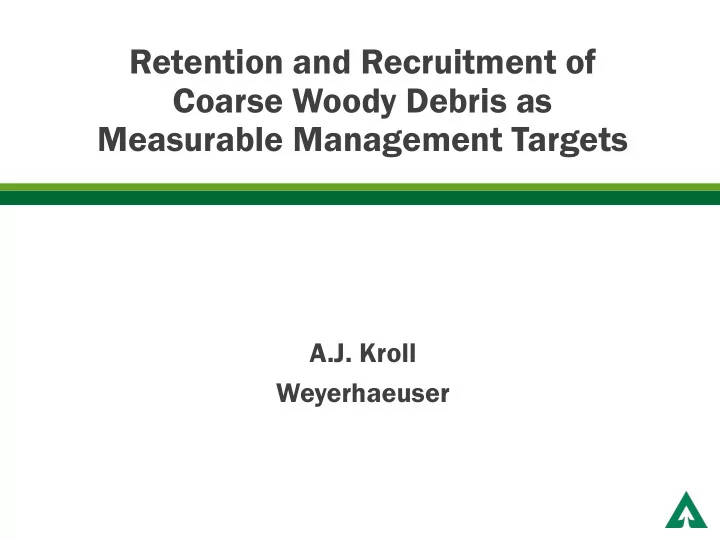

Retention and Recruitment of Coarse Woody Debris as Measurable Management Targets A.J. Kroll Weyerhaeuser
COARSE WOODY DEBRIS IN THE PACIFIC NORTHWEST Substantial amounts of biomass Inefficient wood utilization in past May have created a mid- term “boom” Older 2 nd growth forests may contain large amounts of CWD Many taxa rely on large structures 2 | 3/5/2018
4 | 3/5/2018
A GLANCE BACKWARDS In a topographically diverse landscape with erosible soils and substantial precipitation, CWD played a critical role in “knitting” the landscape together 7 | 3/5/2018
MOVING BEYOND MOVING PARTS Retention and decay of CWD on site contributes to the significant productivity of PNW forests: not only the biological diversity but the ability to grow massive, long-lived individuals of numerous species 8 | 3/5/2018
MEET YOUR NEIGHBORS Douglas-fir Can live for ~200-1000 years 10-12 feet in diameter and 300+ feet tall Regenerates quickly after disturbance; shade intolerant in some areas Can dominate all successional stages Snags and downed logs can last decades Excellent structural properties: a premier building material 9 | 3/5/2018
RECRUITMENT Fires, windstorms, volcanoes, and insects Various scales and intensities Disturbance determines CWD quantity and quality Management alters these scenarios 10 | 3/5/2018
INHERITANCE Linden, D.W. and G.J. Roloff. 2013. Forest Ecology and Management 310 :1045-1056. 12 | 3/5/2018
DO RETENTION GUIDELINES MEET SPECIES NEEDS? OREGON WASHINGTON Feature Number Minimum Minimum Number Minimum Minimum per acre height diameter per acre height diameter Wildlife 2* 30 feet 11 inch dbh 3** 10 feet 12 inch dbh Reserve Tree >10 feet 3 ; logs >20 feet 3 12 inch dbh Down Log 2 6 feet 2 20 feet count as 2 at small end logs 30 feet Green with 1/3 2* 30 feet 11 inch dbh 2 10” dbh Recruitment live crown *OR forest practice rules stipulate leaving wildlife trees or green recruitment trees. **If wildlife reserve trees are not present, only 2 green trees per acre. 14 | 3/5/2018
Oregon Slender Salamander ( Batrachoseps wrighti ) Ensatina ( Ensatina eschscholtzii ) 15 | 3/5/2018
UTILIZATION - Will 2 logs/acre support persistence of Oregon slender salamanders? Plots are 81 m 2 Plot occupancy ( θ ) Plot abundance ( λ ) 16 | 3/5/2018
RESULTS - 88 harvest units, 2013-2017 Oregon slender Ensatina 1.0 Abundance Mean estimate (90% CRI) 0.5 0.0 0.6 Occupancy 0.4 0.2 0.0 0 2 4 6 0 2 4 6 Downed wood (count) 18 | 3/5/2018
DISTRIBUTION 19 | 3/5/2018
METHODS Experimental Design and Analysis Density Clumped Dispersed Random assignment to one of created snags created snags 6 treatments: dispersion × density Low (0.5 created snag/ha) Landscape was characterized in a 1000 m buffer around each stand Medium (1 created snag/ha) Used median NN distance to quantify dispersion High Changes to dispersion since 1999 (2 created snags/ha) 20 | 3/5/2018
Does landscape composition interact with local conditions? Habitat surplus and habitat source hypotheses Habitat source hypothesis Habitat surplus hypothesis Early successional (ES) species group Early successional (ES) species group Mature forest (MF) species group Mature forest (MF) species group Percentage of created snags used for nesting High High Low Low Low High Low High Percent of mature forest in landscape Kroll, A.J. et al. 2012. Biological Conservation 152 :145-151 . 21 | 3/5/2018
RESULTS Support for the habitat surplus hypothesis Mature forest (MF) Early successional (ES) Median nearest neighbor distance = 5 m Median nearest neighbor distance = 5 m Median nearest neighbor distance = 45 m Median nearest neighbor distance = 45 m Median nearest neighbor distance = 113 m Predicted percent of created snags Median nearest neighbor distance = 113 m 15 50 40 used for nesting 10 30 20 5 10 0 0 10 20 30 40 50 60 10 20 30 40 50 60 Percent of surrounding landscape (1 km radius) in mature forest (> 40 years of age) 22 | 3/5/2018
23 | 3/5/2018
THE FUTURE IS ARRIVING MOMENTARILY Douglas-fir is an invasive species with a recent evolutionary history in the PNW Directional selection against large trees continues Douglas-fir capitalized on a climatic window that is closing Conserving the ecological infrastructure to grow, retain, and process the largest terrestrial organisms on the planet is the goal 27 | 3/5/2018
Recommend
More recommend